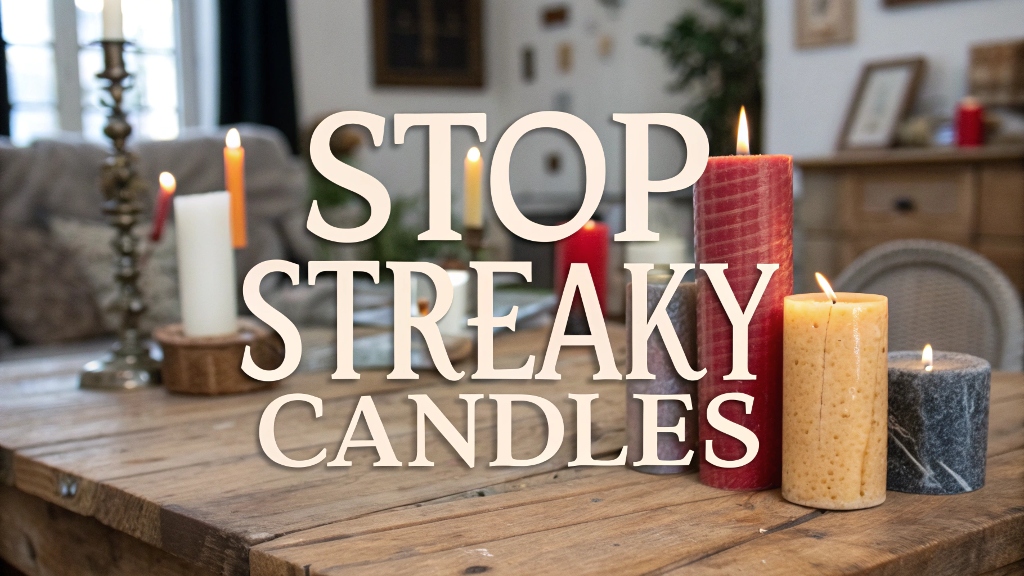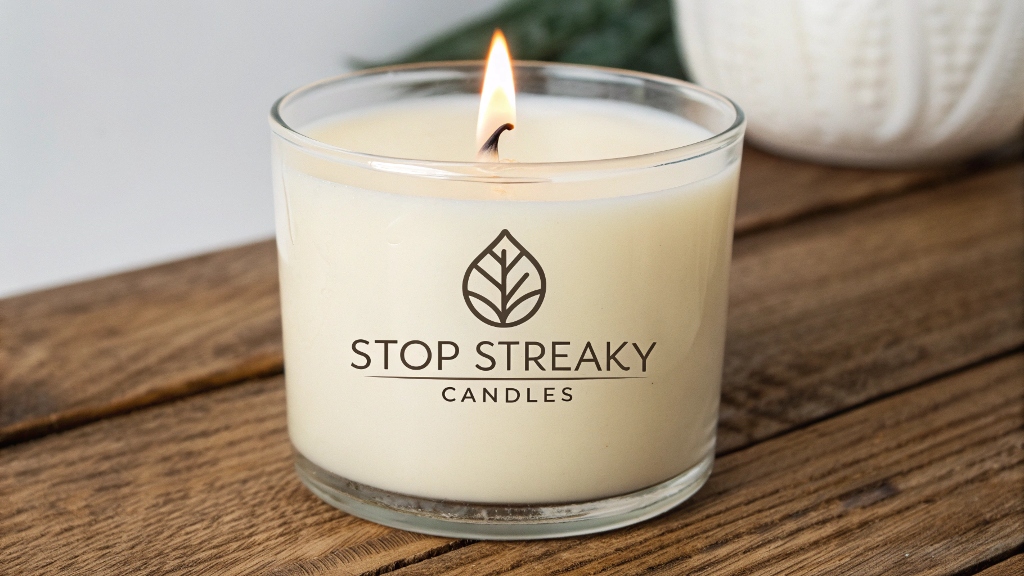Stop Streaky Candles: Proven Tips to Avoid Candle Dye Streaking for Smooth Results Every Time

Have you ever poured what seemed like a perfect batch of candles, only to see uneven coloring and unsightly streaks? You’re not alone. Candle dye streaking is one of the most common (and frustrating) problems for candle makers, whether you’re just starting out or have years of experience. Fortunately, there are several proven ways to prevent it.
In this guide, we’ll explore what causes dye streaking and how you can avoid it for good. Whether you’re using liquid dyes, color blocks, or chips, you’ll find actionable tips that help you create stunning, even-colored candles.
I learned this the hard way. Early in my candle-making journey, I made a beautiful lavender-scented batch. The wax looked perfect in the pot. But once cooled? It was filled with dye trails. That failed batch led me down a rabbit hole of research, testing, and practice.
Today, I’m sharing what I’ve learned so you don’t have to go through the same frustration. If you’re looking to improve your candle craft and color consistency, explore The Straight Choice for more great resources and tools.
Understanding Why Dye Streaking Happens

Before you fix the problem, you need to know what causes it. Candle dye streaking usually shows up as patches, swirls, or lines of uneven color in your candle. These streaks happen when the dye doesn’t dissolve properly or doesn’t bind evenly with the wax.
Here are the main culprits:
- Incorrect melting temperature: If the wax isn’t hot enough, the dye won’t dissolve properly.
- Wrong type of dye: Using craft dyes not meant for candles can cause streaking or separation.
- Inadequate mixing: Simply stirring the dye for a few seconds won’t cut it.
- Adding dye too late: Timing matters—late additions may not bind well with the wax.
This issue is especially common with solid dyes like chips or blocks. These take more time and heat to dissolve evenly compared to liquid dyes.
When I was experimenting with new scents and colors, I noticed streaking almost always happened when I rushed the mixing step. Once I slowed down, monitored my wax temperature closely, and followed a strict stirring method, the results improved instantly.
To reduce streaking, you must focus on these factors from the beginning.
Mastering the Art of Dye Mixing in Candle Making
Getting a vibrant and even candle color begins with mastering your mixing process. It sounds simple, but this is where most people slip up. The key? Precision, temperature control, and patience.
If you’re wondering how to create blue, you need to know that certain colors require specific base combinations. You can learn more about the science behind it.
Now, back to mixing.
Here’s how to get it right:
- Melt the wax to the correct temperature
For most paraffin and soy waxes, this is between 170°F to 185°F. Check your wax supplier’s recommendations. - Add your dye at the right temperature
This is key! Too cool, and the dye won’t fully melt. Too hot, and it may break down. - Stir thoroughly
Stir for at least 2–3 minutes to fully incorporate the dye. Use a silicone spatula or metal spoon. Stirring helps distribute the pigment evenly. - Use a digital thermometer
It’s not a guessing game. Tracking the exact temperature ensures that your dye bonds at the ideal time. - Test before committing
Pour a small test candle before making a big batch. This lets you catch any issues early.
Research from the National Candle Association shows that 67% of candle color issues stem from improper dye dissolution and uneven blending. Don’t let your batch become part of that stat!
Choosing the Right Type of Candle Dye
Not all dyes are created equal. You have to choose the right type for the wax and fragrance you’re working with. This decision can make or break your final product.
Here are the most common types:
- Liquid dyes
These dissolve quickly and mix easily. Ideal for beginners or large batches. - Dye chips
Cost-effective and convenient but take longer to melt. Ideal for small batches. - Color blocks
Great for deep, rich hues. However, they can be tricky to portion correctly. - Powdered dyes
Intense color, but the hardest to mix. Usually better for advanced makers.
If you’re using soy wax, avoid powdered dyes unless you’re experienced. They can clump and cause streaking. For paraffin, liquid dyes tend to yield the best results.
My go-to is liquid dye. It’s more expensive, yes, but the consistent results are worth it. When I switched to liquid after months of streaky failures with chips, my candles came out smooth every time.
Remember: Always buy dyes specifically designed for candles. Never substitute with fabric or food dye. They simply won’t mix right.
The Role of Fragrance and Additives in Dye Streaking
Fragrance oils can mess with your color. Surprised? Many are.
Some fragrances have a thick base that reacts with wax, affecting how the dye bonds. Others contain alcohols that may cause streaking or spotting. Additionally, adding too much fragrance can oversaturate the wax, pushing out the dye.
To avoid this:
- Use fragrance oils made for candles
Cheap oils may not be stable when heated. - Keep your fragrance load between 6–10%
Most waxes can’t hold more than 10%. Exceeding that risks streaks and sweating. - Add fragrance at the right temperature
Usually 160°F–180°F. Adding too hot can break down both the scent and the color.
Additives like stearic acid (used for harder candles) may also impact how the color sets. If you use additives, adjust your dye load accordingly and test a small batch.
In one of my earlier batches, I used a cinnamon fragrance and noticed strange color marbling. Turned out the oil was thick and wasn’t mixing well. Swapping it with a candle-approved oil fixed the issue.
Tools and Best Practices for Flawless Candle Color
You don’t need fancy tools to avoid dye streaking—but you do need the right ones. A few affordable investments can save you hours of wasted work.
Must-have tools for dye mixing success:
- Digital scale – for measuring wax, dye, and fragrance with precision.
- Thermometer – to monitor wax and fragrance temperatures accurately.
- Silicone spatula or stainless spoon – for thorough stirring without residue.
- Clear containers for testing – help you see how dye distributes.
- Notebook or candle journal – track recipes and note what worked or failed.
Additionally, here are a few tips that’ll instantly level up your game:
- Filter your wax: If you notice leftover particles, strain your wax before pouring.
- Mix in a well-lit space: Streaks and swirls are easier to spot under bright light.
- Stay consistent with brands: Switching wax or dye brands mid-project can cause unpredictable results.
Professional candle makers often use a “pour test” after mixing, where they drip a bit of the mixed wax on white paper to check for even color. This simple trick helps catch issues early.
Read More Also: Empathy Activities for Kids: A Fun and Meaningful Guide
Conclusion
Candle dye streaking can be disheartening, especially when you’ve put effort, time, and money into your creations. But with the right knowledge and habits, it’s a problem you can leave in the past.
Focus on:
- Choosing the right dye for your wax.
- Monitoring temperature at every stage.
- Mixing thoroughly and patiently.
- Testing before scaling up.
- Using quality fragrance oils.
Every candle maker has faced streaks at some point. The key is to learn, adjust, and grow. Now that you know how to prevent streaking, you’re one step closer to creating candles that look as good as they smell.
Have you experienced dye streaking in your candles? Share your tips or questions in the comments. Don’t forget to share this guide with fellow candle lovers to help them, too!
Read More Also: How to Sharpen Lawn Mower Blades at Home: Easy Steps for a Cleaner Cut
FAQs
### What causes dye streaking in candles?
Dye streaking is caused by incomplete mixing, incorrect dye temperature, or using non-candle-safe dyes.
### Can I use food coloring in candles?
No. Food coloring is water-based and doesn’t mix with wax, leading to clumping and streaking.
### What’s the best dye type to avoid streaks?
Liquid dye offers the most consistent results and is easiest to mix, especially for beginners.
### How do I fix streaky candles?
You can remelt the candle and stir it thoroughly at the correct temperature to redistribute the dye.
### Does fragrance oil affect candle color?
Yes. Some oils can interfere with dye bonding. Always use candle-safe oils and test beforehand.







